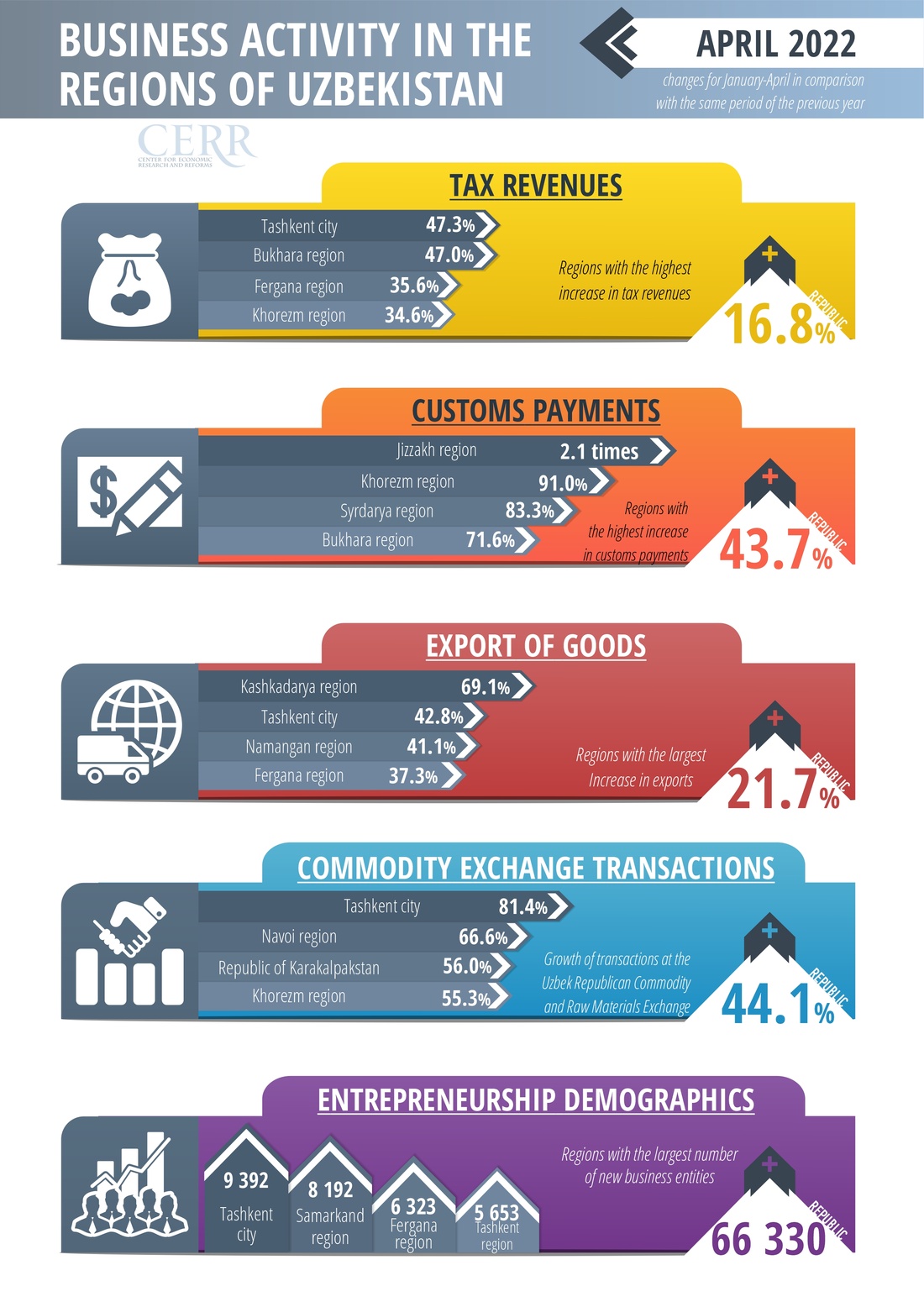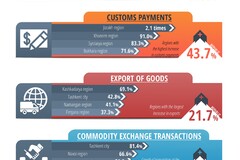The analysis of business activity in the context of the regions of the Republic of Uzbekistan is calculated monthly by the CERR based on operational data (monitoring of all regions of the republic, according to the data of the State Customs Committee, the State Tax Committee, the Central Bank and the UzEx).
The monitoring results showed that the volume of tax revenues of the republic in the period from January 1 to April 30 this year increased by 16.8% compared to the same period last year.
At the same time, a significant increase in tax revenues was recorded in Bukhara (by 37.0%), Ferghana (by 35.6%), Khorezm (by 34.6%), Samarkand (by 33.3%) and Andijan (by 30.2%) regions, in the Republic of Karakalpakstan (by 30.7%) and in Tashkent city (by 47.3%).

The growth of tax revenues was ensured due to positive changes in the economy, improvement of the tax administration system, including the introduction of new administrative tools, digitalization and automatization of processes, legalization of entrepreneurial activity and simplification of the procedure for compliance with tax legislation.
Receipts on customs payments for the analyzed period increased by 43.7% compared to the same period 2021. The largest increase in customs receipts was observed in Jizzakh (2.1 times), Khorezm (91.0%), Syrdarya (by 83.3%), Bukhara (by 71.6%), Kashkadarya (by 70.0%), Andijan (by 66.7%) regions and Tashkent city (by 45.5%).
The increase in customs revenues was achieved due to the growth of foreign trade turnover, the increase in the country's production capacity, simplification of customs administration procedures, digitalization and automatization of processes, including the widespread use of the risk management system by customs authorities.
According to the State Customs Committee, the volume of exports of goods from the beginning of this year to April 30 increased by 21.7% compared to the same period last year. A significant increase in the volume of exports of goods was noted in Kashkadarya (by 69.1%), Namangan (by 41.1%), Ferghana (by 37.3%), Samarkand (by 33.8%), Syrdarya (by 29.7%) regions and in Tashkent city (by 42.8%).
The increase in Uzbekistan's exports is explained by the raise of growth rates of exports of industrial goods, food products, chemicals and agri-food products.
A decrease in exports of goods was observed in Bukhara (by 25.8%), Surkhandarya (by 7.0%) regions and in the Republic of Karakalpakstan (by 18.1%).
The reduction in exports in the Bukhara region is caused by the fact that in January-April 2022, exports of cotton fiber in the Bukhara region decreased, which is due to the direction of these products to the domestic market.
The decrease in exports in the Republic of Karakalpakstan is explained by a reduction in exports of plastics and products made from them and yarn, pharmaceutical products and the full cancellation of exports of cotton fiber with the redirection of these products to the domestic market.
At the same time, the decrease in exports in Surkhandarya region is associated with a reduction in exports of fruit and vegetable products and the redirection of cotton fiber and yarn to the domestic market.
The volume of transactions on the Uzbek Republican Commodity Exchange for the analyzed period increased by 44.1%. A significant increase in exchange activity is observed in Navoi (by 66.6%), Khorezm (by 55.3%), Jizzakh (by 50.9%), Samarkand (by 42.1%) regions, in the Republic of Karakalpakstan (by 56.0%) and in Tashkent city (by 81.4%).
The growth in the volume of transactions in these regions is ensured by increasing the sales of such goods as automobile gasoline, diesel fuel, rolled ferrous and non-ferrous metals, cotton fiber, cathode copper, polyethylene, feed wheat, construction and household materials, mineral fertilizers, technical seeds, sugar, alcohol, etc.
At the same time, a decrease of 13.2% was observed in the Syrdarya region, which is explained by a decrease in the number and volume of transactions for trade in polypropylene, vegetable oil, cotton fiber, ferrous metal, cement, technical seeds, wheat, livestock feed, soap product and liquefied gas.
During this period, 66,330 new business entities were created, the largest number of which were registered in Samarkand (8,192), Ferghana (6,323), Tashkent (5,653), Kashkadarya (5,592), Andijan (5,280) regions and in Tashkent city (9,392).
Yusup Zhumabayev, CERR






















leave a comment